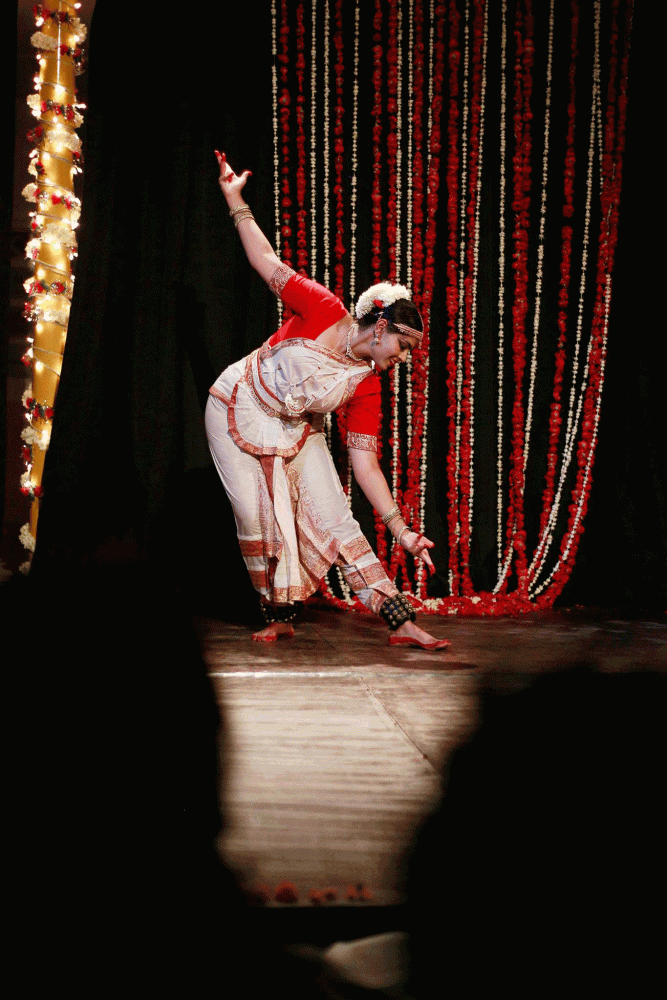The Joy of Dance
By Tehmina Ahmed | Performing Arts | Published 8 years ago

In some ways the patio of the Alliance Francaise is not the best place for a dance performance. There are pet cats underfoot, the stray mosquito flying by, maulanas belting out the maghrib azaan and a few road-crazed drivers just outside, playing their own symphonies on the car horn.
But on one enchanted evening in April, a classical dance performance transported the audience to another realm. The dancer was Leila Rasul Khan, and the occasion was her Arangetram — a traditional debut for the classical dancer.
Leila began to study dance with the theatre activist and dancer Sheema Kermani when she was six years old, and 12 years later, her guru decided it was time for her debut performance.
In her presentation, Sheema paid tribute to her own guru, L. J. Ghanshyam, who had learnt to dance at the Uday Shankar School of Dance in Almora. Moving to Karachi in the early ‘50s, he set up an institute to teach yoga and classical dance. The Ghanshyam Rhythmic Arts Centre did a fine job of fostering young talent and continued with its task till the dark days of the Zia regime when dance suddenly morphed into a threat to morality, if not to Islam. Ghanshyam and his wife persisted with their pioneering work even after their house was stoned and they found hostile chalkings on the boundary wall. Eventually, they left their adopted home for the United States, where Ghanshyam continued to teach classical dance.
Sheema’s organisation, the Tehrik-e-Niswan, responded to the challenge of the Zia years on the cultural front, using dance, drama and music to highlight social issues. Sheema, who had learnt Kathak from Ghanshyam, later studied Bharatanatyam with Leela Samson in India. She taught her
students Kathak, Bharatanatyam, Odissi and other dance forms, as had Ghanshyam.
Bharatanatyam demands intense and gruelling discipline of the aspiring dancer. Believed to be one of the most ancient dance forms of India, it combines precise body movements with facial gestures and symbolic hand positions or mudras, to convey emotions and meaning. Myths, legends and spiritual ideas thus take on a tangible form through the artist’s interpretation.
A solo performance of Bharatanatyam traditionally presents a set of items in a defined sequence.
Thus Leila began the performance at her Arangetram with the Pushpanjali, a prelude that she performed with aplomb. Coming next, the Alarippu is a piece of pure dance, a rhythmic invocation and it prepares the dancer for what lies ahead. In the Jatiswaram, melody is added to rhythm and this piece of pure dance was one of the highlights of the evening. True to its origins, the sequence seemed to invoke an ancient world.
The Shabdam adds words to music and the lyrics Sheema chose were from a poem by Nazir Akbarabadi. A Muslim poet writing a poem in praise of Lord Krishna and his flute does epitomise the Ganga Jamuna culture, but fusion can be a hard thing to pull off. In this case, Kanhaiya Ji Ka Raas, choreographed by Sheema, worked.
The Varnam, a central feature of the performance, was passed on in true guru-shishya fashion from Ghanshyam to Sheema, and from Sheema to her protégé, Leila.
The performance was rounded off by the Padam or Abhinaya — a complex and expressive piece — and ended with the lively movement and music of the Tillana.
All along, the audience watched in rapt attention and gave the young dancer a standing ovation as the performance came to an end. For Leila, the Arangetram may have been the end of a particular stage in the journey, but there’s a long road ahead, a road worth following as much for the art as it is for the sheer joy of dance.


